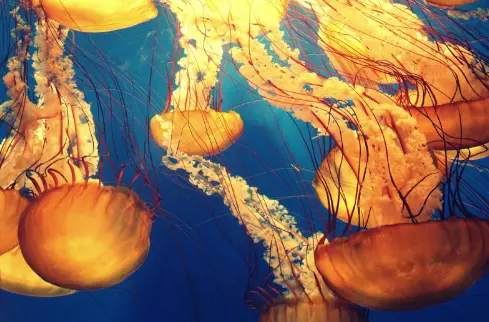1. Box Jellyfish

Flickr
Undoubtedly the most dangerous of all jellyfish, the Box Jellyfish is infamous for its lethal venom, capable of causing heart failure in mere minutes. Found in the waters of Australia and the Indo-Pacific, this jellyfish is as deadly as it is elusive.
2. Irukandji Jellyfish (the “Doom” Jellyfish)
YouTube
Despite its minuscule size, the Irukandji Jellyfish – otherwise known as the “Doom” Jellyfish – packs a powerful punch. Its venom can lead to Irukandji syndrome, characterized by severe pain, hypertension, and potentially life-threatening symptoms. It prowls the waters near Australia.
3. Sea Wasp
Flickr
A type of Box Jellyfish, the Sea Wasp holds potent toxins that cause extreme pain and can be fatal. Known for its transparent, ghostly appearance, it floats in the waters of northern Australia, cautioning swimmers to keep their distance.
4. Portuguese Man o’ War
Flickr
Though not technically a jellyfish, the Portuguese Man o’ War is a siphonophore known for its painful sting. Its tentacles can extend dangerously long, deploying venom that can lead to severe reactions and intense pain.
5. Lion’s Mane Jellyfish
Flickr
Famed for its size with tentacles stretching over 100 feet, the Lion’s Mane Jellyfish resides in cooler waters. Its sting can cause pain and severe reaction in allergic individuals but is typically less fatal than others.
6. Morbakka Jellyfish (the Moreton Bay stinger)
Flickr
Lurking in the coastal waters of Australia, the Morbakka Jellyfish, also known as the “Fire Jellyfish” is known for its painful, long-lasting stings that still require caution, boasting toxins that affect skin and muscle tissue.
7. Alatina Alata (the “Night Stalker”)
Flickr:
Frequently called a “night stalker” due to its peak activity during full moons, the Alatina Alata causes painful reactions upon touch, urging humbling respect among ocean explorers.
8. Nomad Jellyfish
YouTube
Once stretching across the Mediterranean, the Nomad Jellyfish exhibits migratory behaviors aligned with shifting environmental narratives. Notorious in their boasting stings, it presents risks that are especially impactful toward divers.
9. Carybdea Alata
Flickr
Another type of sea Wasp, this jelly is branded by rhythmic moonlit waters, another Box Jellyfish specimen. The Carybdea Alata tempts wandering eyes with its spectacular glow and potent neurotoxins, offering an ethereal yet dangerous enchantment.
10. Mauve Stinger
Flickr
Adorned in vibrant hues, the Mauve Stinger illuminates meditative Asian seas under moon shelled light. Though a sting inflicts pain and irritation, it is less severe than others on this list.
11. Sea Nettle
Flickr
Colorfully stirring the interior waters of the North Atlantic and Pacific, Sea Nettles’ stings inflict moderate to severe discomfort, keeping adventurous beachgoers sober in their pursuits.
12. Moon Jellyfish
Wikimedia Commons
Recognizable across global seas for its gentle, transparent form, the Moon Jellyfish’s toxins are mild, yet enough to cause unpleasant skin irritation upon contact.
13. Cannonball Jellyfish
Flickr
Boasting a spherical orbit, the Cannonball Jellyfish is largely harmless to humans, though its toxins can provoke allergic reactions if encountered in large numbers along the southeastern United States coast.
14. Upside-Down Jellyfish
Housing rich symbiotic flora upon tranquil Bahamian sands, the Upside-Down Jellyfish releases waterborne toxins capturing attention among explorers unmindful of their floating casts.
15. Compass Jellyfish
iStock: Jake Davies
Patiently swaying along the fringes of northern European shores, the Compass Jellyfish presents intrigued beach visitors its distinctive patterns, reminding all of the mild sting residing amid distant charms.
These jellyfish, while fascinating parts of the ocean ecosystem, warrant respectful distance. The more you know about their habits and habitats, the better equipped you are to enjoy the water—appreciating the stunning wonders without falling prey to a dangerous misstep. Always be cautious and stay informed about the beauty that lies beneath the surface.


